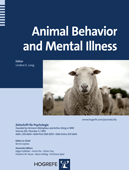What We Can Learn From Animal Behavior
In this issue of the Zeitschrift für Psychologie we have assembled a number of articles and comments that deal with the role of animal behavior in neurobiological and psychological basic research, in behavioral models of psychiatric disorders, and in the treatment of psychiatric patients.
In a short review, Schweinfurth and Lang (2015) introduce several behavioral tests, which address symptoms of depression and anxiety and are commonly used in the development of new psychiatric drugs and the exploration of their efficacy.
Juckel (2015) describes how inflammational and immunological processes are connected with the pathophysiology of schizophrenia. In his article, he describes how microglia can induce a rarification of synaptic connections in frontal and temporal brain regions. In this context, he introduces promising inflammational animal models for schizophrenia with high validity that can be used to mimic behavioral as well as neurobiological findings in patients.
Two articles focus on new molecular pathways that might be highly relevant in the pathophysiology not only of cancer, viral infections, and obstetric complications, but also of affective disorders and schizophrenia. Phosphatidylinositol-3-kinase signaling has shown to be changed in patients with schizophrenia and their first degree relatives. In the article by Lang et al. (2015), a combined data set concerning human genetic, psychopathological, and electrophysiological, and animal neurotransmission data is shown. In conclusion, phosphatidylinositol-3-kinase signaling might have an impact on the pathophysiology of schizophrenia (Lang et al., 2015).
Additionally, the regulation of anxiety might be modulated by brain-derived neurotrophic dependent phosphatidylinositide-3-kinase signaling (Leibrock, Hierlmeier, Lang, & Lang, 2015). A behavioral study in mice shows differences in the behavior of gene targeted mice lacking functional Akt isoforms Akt1 (akt1-/-) or Akt3 (akt3-/-) when compared to that of wild type (wt) mice in the open-field test, light/dark transition test, O-maze test, and forced swimming test, which suggests them to be more anxious than their wild type controls (Leibrock et al., 2015).
In the article by Bolten (2015), the influence of early stress, maternal nutrition, social stress, and developmental influences is introduced and discussed.
In conclusion, this topical issue both reviews concepts, methodology, and application of behavioral animal test approaches to psychological research and carries them further by adding new facets. In addition, the influence of animals on human health is shown in a short Research Spotlight on an animal-assisted intervention for recurrent depression (Schramm, Hediger, & Lang, 2015). Several articles describe how animal behavioral tests can open new research directions and answer new molecular challenges. Furthermore, directions for future work are outlined and critically discussed.
References
(2015). Transgenerational transmission of stress pathology: Contributions of rodent models. Zeitschrift für Psychologie, 223, 181–191. doi: 10.1027/2151-2604/a000219
(2015). Inflammational animal models for schizophrenia. Zeitschrift für Psychologie, 223, 157–164. doi: 10.1027/2151-2604/a000216
(2015). Phosphoinositide-dependent protein kinase 1 (PDK1): Impact on schizophrenia risk and endophenotype profil. Zeitschrift für Psychologie, 223, 165–172. doi: 10.1027/2151-2604/a000217
(2015). Subtle impact of Akt1 and Akt3 on exploratory behavior in gene targeted mice. Zeitschrift für Psychologie, 223, 173–180. doi: 10.1027/2151-2604/a000218
(2015). From animal behavior to human health: An animal-assisted mindfulness intervention for recurrent depression. Zeitschrift für Psychologie, 223, 192–200. doi: 10.1027/2151-2604/a000220
(2015). Behavioural testing of mice concerning anxiety and depression: What can we learn from it?. Zeitschrift für Psychologie, 223, 151–156. doi: 10.1027/2151-2604/a000215



